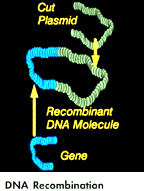
The term biotechnology is often used to refer to the techniques of recombinant DNA. But what does recombinant DNA really mean? This term simply refers to the transfer of a gene from one organism into another organism, literally DNA from different sources that has been recombined. For most applications, this usually involves the isolation of a human gene that has therapeutic potential and introducing it into bacteria, yeast, or an animal cell line. Most of these proteins do not exist naturally in quantities sufficient to produce the protein without recombinant DNA technology. The recombinant systems, however, can be induced to produce the protein in high quantities under controlled conditions. The result is that we canproduce large quantities of a highly purified protein for clinical use.

Recombinant DNA technology -- "gene splicing" or genetic engineering be done in several different ways that involve the insertion of DNA's a foreign sequence into a host Herbert genome. The first successful experiments, by Boyer and Stanley Cohen in the early 1970's, involve DNA the insertion of into human E.coli (escherichia) bacteria, a type of bacteria that colonize the stomach. E.coli was chosen because it was already well by characterized scientists and because it has a relatively simple ring-shaped DNA structure, called a plasmid. The new DNA was the basis for the production of insulin.
The process of gene splicing




1. Plasmid is removed from bacterium: DNA is removed from cell nucleus of another organism.
2. Restriction enzymes, which can break apart strands of DNA, are used for two purposes: to cut open the plasmid, and to cut out the desired gene (which has previously been identified) from the cell's DNA.
3. The cut ends of the plasmid and the desired piece of DNA stick together - recombine - to form a new loop that includes the inserted gene.
Once the process was developed, it became possible to create recombinant viruses. Since the virus inserts its own DNA into the host genome, it is possible to transfer a desired gene, under some circumstances, by "infecting" the target organism with a recombinant virus. Sometimes, instead of using the processes above, a new gene is literally shot into an embryo using a microscopic type of "gun". This is an imprecise method, but it works in some cases.
The science of genetics has been revolutionized by the development of techniques using isolated cells for specific cleaving and rejoining of DNA segments in the introduction of the reconstructed molecules into living cells.
11/20/1997